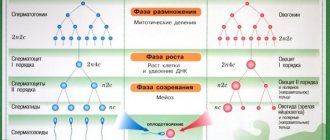Differential psychology is a branch of psychological science that studies psychological differences, typological differences in psychological manifestations among representatives of various social, class, ethnic, age and other groups. This approach is significantly different from others: often in modern psychology they try to identify common psychological processes that are characteristic of all people.
For example, when evaluating the effectiveness of a new therapy, the average effectiveness of the therapy in one treatment group may be compared with the average effectiveness of a placebo (or known therapy) in a control group. In this context, differences between people in their responses to experimental and control manipulations are effectively viewed as errors rather than as interesting phenomena to study.
Individual differences are important when we want to explain how different people behave. In any given study, there is significant variation between the two: response rates, preferences, values, and health-related behaviors are just a few examples. Individual differences in factors such as personality, intelligence, memory, or physical factors (such as height, gender, age, and other parameters) can be used to understand this source of variance.
William Stern is considered the founder of differential psychology, who introduced the concept itself, as well as, interestingly, the term “intelligence quotient.” Of course, this industry was not his pure invention, because traces of it can be found in antiquity. For example, Plato's Republic emphasized the importance of dividing labor according to people's inclinations and abilities. But earlier studies were unsystematic and unrelated to each other.
History of industry development
Before studying this section of psychological science, it is advisable to find out who coined the term differential psychology. This concept was first coined by psychologist William Stern (1871–1938). In 1900, the scientist published a book called “On the Psychology of Individual Differences: Ideas for Differential Psychology.”
Francis Galton, who was a relative of Charles Darwin, made a huge contribution to the development of science. After him, his student Karl Pearson contributed to the development of the direction. He made significant contributions to the field of statistics.
Between 1960 and 1970, behaviorism emerged and influenced the decomposition of differential psychology. Two authors, John Fuller and Bob Thompson, published a paper entitled "Behavioral Genetics." In it they described discoveries in the field of genetics. Thus, the authors explained polygenic transmission and mutations.
Books
This is a brief description of differential psychology as a science. Since the topic is quite complex and voluminous, reading one article will clearly not be enough. Here is a list of books with which you can study it in more detail.
- “Differential Psychology” Sofya Nartova-Bochaver.
- “Differential psychology. Individual and group differences in behavior" Anna Anastasi.
- “Differential psychology and psychodiagnostics” Konstantin Gurevich.
- “Differential psychology: a textbook” Valery Mashkov.
- “Differential Psychology” Alexander Libin.
- “Differential psychology and its methodological foundations” William Stern.
- Neurotic Styles by David Shapiro.
We recommend starting with the book by the founder of differential psychology, William Stern, which is still relevant today.
We wish you good luck!
Did you like the article? Join our communities on social networks or our Telegram channel and don’t miss the release of new useful materials: TelegramVKontakteFacebook
We also recommend reading:
- Storytelling
- Cognitive psychology and cognitive psychotherapy
- Psychology of Advertising
- Scientific knowledge: basics
- Situationism in psychology and human behavior
- Psychosemantics
- Psycholinguistics as a tool for in-depth study of speech and language
- Practical psychology
- Criminal psychology
- Wundt's method of studying psychology
- Cattell's personality model
Key words: 1 Communications, 4 Psychoregulation
What tasks do followers of the direction face?
Any direction of psychological science poses a number of tasks on which various studies are conducted. The goals of differential psychology include:
- Analysis of group distribution of characteristics.
- The study of character traits and their manifestations.
- Development of a theoretical basis for psychodiagnostics.
- Highlighting individual differences.
- Explaining behavior changes.
- Determining differences between people and the reasons for their occurrence.
The results obtained after conducting research help criminologists, judges, teachers, and managers when recruiting personnel.
Subject and tasks of the psychology of individual differences.
Somatotyping.
The author of the somatotyping system, American psychologist and physiologist W. Sheldon, proceeded from the fact that different body types cannot be considered as discrete types: the extreme options described by Kretschmer do not allow an unambiguous assessment of the body structure of most people, therefore, it is logical to assume that body types have a continuous distribution. But in order to identify a continuous distribution, it is necessary to introduce a quantitative assessment of some body parameters. There are three such basic parameters, as Sheldon believed.
He suggested that the structural features of the body are a consequence of the relative development of tissues originating from three germ layers - endomorphic, mesomorphic and ectomorphic. Having collected photographs of 4,000 students, he selected three groups, each of which was characterized by extreme expression of one of the three components. A more detailed study of representatives of the three extreme groups revealed the following features.
Endomorphs
have a large amount of subcutaneous fat. They have a large belly, weak arms and legs, thin wrists and ankles, and a round head. They have large liver, spleen, heart and intestines.
Mesomorphs
have developed muscles and wide bones. They have broad shoulders and a voluminous chest, muscular arms and legs, a cubic head, and a large heart. The subcutaneous fat layer is minimal.
Ectomorphs
have a developed nervous system (meaning morphology). Their ratio of skin surface to overall body size is greater than that of representatives of the other two extreme groups. They have a narrow chest and stomach, thin and long arms and legs, and an elongated face. The subcutaneous fat layer is almost absent.
Having described the extreme groups, Sheldon analyzed the distribution of the three main body composition components in a large sample of subjects. Each subject, depending on the severity of the physique component, received a certain score. The maximum severity corresponded to 7 points, the minimum - 1 point. The 7-point scale was constructed in such a way that the intervals between points were equal. In other words, someone who has 1 point, for example, in the ectomorphic component, is different from someone who has 2 points, just as someone who has 2 points is different from someone who has 3 points. As a result, each subject receives three points, corresponding to the development of their endomorphic, mesomorphic and ectomorphic components. The rating of extreme endomorphs will be 7-1-1, extreme mesomorphs - 1-7-1, extreme ectomorphs - 1-1-7.
Subsequently, the 7-point scale was transformed for greater accuracy into a 13-point scale, and the anthroposcopic methods underlying the determination of each of the components were brought to a fairly reliable level: in 90% of cases, the diagnosis made by different researchers coincides.
Depending on the development of one or another component, there is a greater or lesser tendency to somatic and mental illnesses, i.e., as in Kretschmer’s typology, in this case it is also indicated that the biological prerequisites for physique are largely common to a wide range of people. circle of phenomena. Thus, ectomorphs are more likely to develop tuberculosis than people with other body types; endomorphs are more likely to have myocardial infarction and some forms of diabetes
Psychology of individual differences and psychodiagnostics.
Subject and tasks of the psychology of individual differences.
Many manifestations of a person - whether we are talking about his constitution (in the broad sense of the word), individual personality traits or individuality - are deservedly the subject of consideration of many scientific disciplines related to psychology: philosophy and biology, medicine and sociology, anthropology and cultural studies. Not only inter-, but also intra-disciplinary, intra-psychological integration of various semantic contexts of the same concept leads to semantic differentiation of such important constructs as temperament, character, style, intelligence, abilities, which have come into use in general psychology and psychophysics.
Various historiographical sources note that the concept of “individuality” began to be recognized by society itself as the foundation of subjective reality only in the Renaissance. However, the sages of the Ancient East and ancient Greek philosophers already created treatises, the subject of description and analysis of which were human differences observed in everyday life.
V. Stern managed to collect contemporary ideas about the differences between people into a holistic concept, which he initially designated as “the psychology of individual differences,” and then, adding the topic of group differences and the typological approach developed by characterology, as “differential psychology.” In accordance with the two main goals of human science (or psychognostics) and human metrics (or psychotechnics) - the core of future science was to be research into intelligence and abilities, character and temperament, types of memory, attention, thinking, etc., as well as a comparative analysis of psychology geniuses and losers, the mentally ill and the super-gifted, the study of racial characteristics and so on. At the same time, the author of the concept especially emphasized that the comprehensiveness of differential psychology is of a completely different kind than the comprehensiveness of general psychology. And it lies in the fact that the formal characteristics of individuality that are distinguished by the greatest stability among the analyzed variations of behavior are subject to differential psychological research. The category of mental variability also becomes the “cornerstone” of the new teaching.
tasks of differential psychology, among which the most important since the times of F. Galton, A. Binet and V. Stern remain:
1. Study of various sources of variability among measured traits.
2. Study of relationships between measured characteristics.
3. Analysis of group distribution of characteristics.
Considering the specifics of the internal areas (subsections) of differential psychology, we can say that the emphasis is placed as follows (by item numbers): (1) the area of individual differences, (2) the area of typological differences; (3) area of group differences.
Unfortunately , V. Stern’s idea of creating an integral science of human individuality turned out to be only half realized. The lack of theoretical generalizations and conceptual integrations has led to the emergence of a huge amount of disordered empirical data in the experimental field and to the formation of, although very valuable, practically unrelated theoretical directions in the field of methodological analysis. Let us note the most common trends in modern science about human differences, each of which hides both certain paradigmatic attitudes and epistemological and methodological pitfalls inevitable on the path of knowledge: sociobiological analysis, psycholinguistic modeling, psychophysiological approach, psychogenetic theory, etc.
Differential psychology studies the nature and sources of individual differences. Studies of the behavior of diverse living beings have shown the existence of individual differences in the nature of learning, emotional reactions, motivation and other behavioral characteristics. For example, the smartest rat can act more efficiently than a stupid one.
2. The place of individual differences psychology among other psychological disciplines.
As already mentioned, individual differences are inherent in absolutely all psychological characteristics, and over the hundred-plus years that the psychology of individual differences has existed, a variety of them have attracted the attention of researchers. Nevertheless, it is possible to identify those psychological areas, the study of which has always been a priority when studying differences between people.
First of all, since the emergence of ideas about individual differences, the attention of researchers has turned to the study of socially significant characteristics, i.e. those characteristics by which people are assessed by society. A person’s abilities, his mental development, the characteristics of the personal sphere that determine relationships with other people, from the very beginning (since the second half of the 19th century) were and remain the main object of study of the psychology of individual differences.
Somewhat later, interest appears in the physiological basis of individual differences, and this includes among the psychological characteristics under consideration those of them that underlie socially significant characteristics, determining the dynamics of their course, but not influencing their content. Such features include, for example, the properties of temperament.
The search for dynamic, basic characteristics, in turn, requires the development of theoretical ideas about the hierarchical structure of psychological properties and leads to an expansion of the range of psychological characteristics considered by the psychology of individual differences.
The breadth of problems and interest in different psychological spheres complicates the process of establishing the psychology of individual differences as an independent, strictly defined area of psychology. The boundaries between different psychological disciplines are generally arbitrary, and each area of research has significant areas of overlap with other areas. The division of psychology into specific disciplines is more the result of a social contract than the specifics of these disciplines. This is clearly visible when comparing the American and European traditions, which are based on different principles of classification of psychological disciplines and therefore distinguish far from coinciding lists of them in the composition of psychological science.
As for the psychology of individual differences, they try to determine its place among other psychological fields, as a rule, by the object of its study (intelligence, personality, etc.), and therefore it is often considered not as an independent field, but as one of the areas of research in another, more general psychological discipline. There are quite a lot of such disciplines - psychophysiology, personality psychology, developmental psychology, social psychology, and finally, behavioral genetics, which has interdisciplinary connections with psychology.
The list can be continued, but it is difficult to agree with this approach. Recognizing his correctness would simultaneously mean recognizing that between different psychological properties, between different aspects of a person’s single mental life, there are insurmountable barriers: what is obtained in the study of intelligence does not and should not have any relation to what is obtained in the study of personality, and what was obtained from studying the nature of psychological properties has nothing to do with their structure. Such a narrow departmental approach to the study of psychological properties prevents the integration of ideas about a person, and in relation to the psychology of individual differences, it prevents the integration of knowledge about the patterns of formation of individual differences, about those patterns that go far beyond the characteristics of a particular phenomenon and are of a general nature.
3. The emergence of the psychology of individual differences as an independent field of knowledge.
F. Galton
(1822-1911) - English biologist, anthropologist, outstanding follower of Darwin.
In 1883, a book about the psychology of individual differences. The main work is “ The Heredity of Talent
” (1869) → the idea of the heredity of talent and an attempt to substantiate it using the statistical method. Denying the natural equality of people with regard to mental abilities, Galton argued that abilities are inherited in the same way as physical characteristics. An indicator of talent is a high reputation in public and professional life. An argument that proved the hereditary nature of talent was cases when more or less famous personalities had prominent relatives. That is, Galton viewed talent as a continuous chain, the beginning and end of which were somewhere very, very far away... This comrade divided all people according to their natural abilities into classes separated by small intervals. The number of people in each class is not the same and obeys Quetelet’s law of deviation from the average, according to which the frequency of deviation from the average is a function of their size.
Galton tried to evaluate the talent of different races by the number of geniuses (without taking into account the social conditions of life) and concluded that it is not the same in genotype. Some of his statements are openly racist. From the fact that at present there are no people equal to Socrates or Phidias, Galton concluded that human nature was deteriorating and saw a means of improving it in the systematic reproduction of gifted people, which would lead to the formation of a new human form. He develops these thoughts into a special field - eugenics
.
Approaching man from a frank biologizing position, using the results obtained through the use of a statistical approach, Galton explained the distribution of talent by natural factors. He identified hereditarily determined qualities of the mind: energy of body and spirit, persistent endurance and constancy, an innate attraction to science, health, independence of judgment.
In all of Galton's experiments, he was interested in an aspect that was completely unusual at that time - the genetic (hereditary) basis of individual differences.
between subjects.
It was this interest that prompted him to invent experimental models and plans. In order to study the influence of upbringing and environment, Galton undertook a study of identical and fraternal twins by collecting questionnaires. This introduced a new method of scientific research - the twin method
. The general conclusion was made that there is a huge intra-pair similarity between twins of the same sex, apparently identical twins. In fraternal twins, differences were observed within the pair, but this did not shake the general conclusion about the decisive role of heredity.
From studying talent, Galton moved on to measuring the mental functions of each person in order to assess his intelligence. He introduced tasks (tests) to measure the acuity of sensations (visual, auditory, olfactory, etc.), reaction time, inventing the necessary instruments for this (Galton's whistle to determine the upper threshold of hearing, Galton's ruler to determine the eye, etc.). Associative abilities, imagination, and speed of judgment formation were tested. The test results were used to judge individual differences between people. So, to study imagination, Galton came up with a special questionnaire. The subject was given the task of imagining a certain object, and then answering questions about the characteristics of the ideas that arose in him, and comparing these ideas with perceptions in terms of their brightness and certainty. Galton was again interested primarily in the hereditary conditionality of the differences discovered (for example, how similar the imaginary images of siblings are).
Galton believed that sensory discrimination tests could serve as a means of assessing intelligence, since he proceeded from a sensualistic attitude and considered the senses to be the only source of knowledge that provides the basis for the actions of the intellect. In 1882 he founded an anthropometric laboratory in London
. Here, for a small fee, each person could test his sensory discrimination sensitivity and motor processes. He saw the practical significance of research data for the selection of people in connection with government tasks in the field of industry, army, and colonial policy.
Galton also tried to explore individual differences in the area of character. He expressed ideas about the connection between the psyche and appearance of a person, using for this purpose the technique of composite portraits. These attempts were unsuccessful.
Of all Galton's many ideas, the idea of testing mental functions received a particularly productive continuation. According to Galton, tests can therefore measure mental processes, since they, being a function of the brain and being hereditarily determined, have a certain constancy throughout a person’s life. It was in this understanding that testology
. Its important area was statistical research based on identifying relationships between indicators obtained using a wide range of tests.
Research methods
There are several methods used by specialists involved in the development of differential psychology.
Standard Methods
General scientific methods are divided into two large groups:
- Observation is a method of description, the essence of which is to observe and record the behavior of the subject.
- An experiment is an experience that is carried out to obtain scientific knowledge. In this case, inspectors interfere in the life of the observed object.
The first method has a number of strengths and weaknesses. Advantages:
- Perception of a person as a whole person.
- Shows the context of an individual's life.
- Observation helps to collect many facts about the natural behavior of an individual.
Flaws:
- The inability to separate incidental phenomena from their accompanying facts.
- The results are recorded manually as a description of what was seen.
- It is not possible to repeat an identical observation to verify the selected points.
The experiment has one significant advantage - it can be carried out as many times as necessary, resolving controversial issues, but it is impossible to see a holistic picture of the individual.
Modeling can be considered a separate method. Its principle is that specialists try in every possible way to recreate the real situation in order to conduct an experiment. The result depends on how accurately the situation is reproduced.
Psychogenetic tests
Experts distinguish two large groups of psychogenic research methods:
- Twins - twins can be dizygotic or monozygotic. Psychologists study representatives of twin pairs to find out what differences appear between them under the influence of genetics and environmental factors.
- Genealogical - methods of studying individual families according to their pedigrees. To study, researchers need to create an accurate family tree.
Studying historical data
Such methods are used to study the lives of prominent personalities or ordinary people. Three research methods are used:
- Diary - the researcher studies an individual personality, describes the stages of development, and the behavior of the subject.
- Autobiographical - studying people using audio and video materials.
- Biographical is a method in which the biography of famous people is studied.
Psychological research
This includes two popular methods:
- Self-esteem - the patient independently explains his mental characteristics, try to describe his behavior. Not every subject can tell about themselves in detail. Many people hide certain aspects because of shyness.
- Self-observation - the individual independently observes his behavior and draws conclusions about its changes.
There is no ideal method to study each person individually. The psychologist needs to combine them depending on the situation and personality traits.
Connections with other sciences
The development of differential psychology is connected with other areas of psychological science:
- Psychophysiology.
- Sociology.
- Psychology of the family.
- General, developmental, social and family psychology.
- Psychiatry.
- Pedagogy
- Psychoconsulting.
- Psychodiagnostics.
Differential psychology studies the differences between individuals and their behavior. Their occurrence is influenced by environmental factors, upbringing, the opinions of other people, and genetics.







